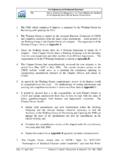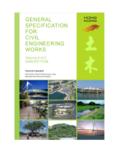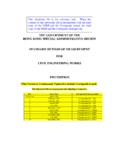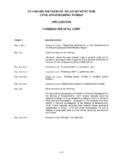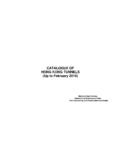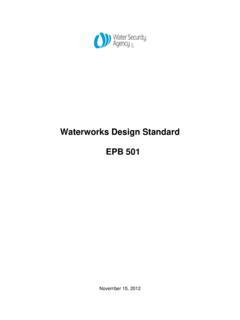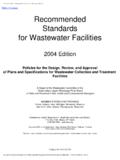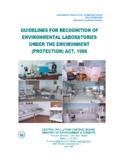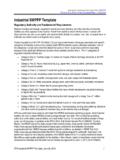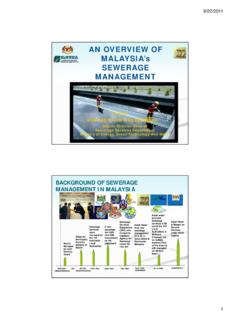Transcription of GEO Technical Guidance Note No. 25 (TGN25) …
1 Geotechnical Engineering Office, Civil Engineering and Development Department The Government of the Hong Kong Special Administrative Region GEO Technical Guidance Note No. 25 (TGN25) Geotechnical Risk Management for Tunnel Works Issue No. 2 Revision: A Date: Page 1 of 10 [CEDD4597][D:\TGN25\TGN ] 1. SCOPE This Technical Guidance Note (TGN) provides Guidance on geotechnical risk management in relation to tunnel works. It does not cover immersed tube tunnels, box culverts, submarine outfalls and underground pipes for drains, sewers and water mains. Any feedback on this TGN should be directed to the Chief Geotechnical Engineer/Mainland East. 2. Technical POLICY The Technical guidelines contained in this TGN were agreed by GEO s Geotechnical Control Conference (GCC) in November 2005. 3. RELATED DOCUMENTS Barton, N. & Grimstad, E. (1994). The Q-System following twenty years of application in NMT support selection.
2 Proceedings of the 43rd Geomechanic Colloquy, Salzburg, Felsbasu, 6/94, pp 428-436. (Re-printed in the course notes on Design Methods for Jointed Rock by Dr N. Barton produced by the Department of Civil and Structural Engineering, Hong Kong Polytechnic University, 24-26 March 1997). Barton, N. (2004). Risk and risk reduction in TBM rock tunnelling. Proceedings of the ISRM International Symposium: Third Asian Rock Mechanics Symposium, Kyoto, Japan, pp 29-38. Burland, J. B., Standing, J. R. & Jardine, F. M. (Ed.) (2001). Building Response to Tunnelling - Case Studies from Construction of the Jubilee Line Extension, London. Volume 1: Projects and Methods. Volume 2: Case Studies. CIRIA Report No. SP200, CIRIA, London. BSI (2001). BS 6164:2001 Code of Practice for Safety in Tunnelling in the Construction Industry. British Standards Institution, London, 124p. BTS/ICE (2004). Tunnel Lining Design Guide.
3 British Tunnelling Society and Institution of Civil Engineers, London, 184p. BD (2005). Code of Practice for Site Supervision 2005. Buildings Department, Hong Kong, 99p. Clayton, C. R. I. (2001). Managing Geotechnical Risk - Improving Productivity in UK Building and Construction. Institution of Civil Engineers, London, 80p. Essex, R. J. (Ed.) (2007). Geotechnical Baseline Reports for Construction: Suggested Guidelines. American Society of Civil Engineers, Reston, USA, 62p. Eskesen, , Tengborg, P., Kampmann, J., Veicherts, (2004). Guidelines for tunneling risk management: International Tunnelling Association, Working Group No. 2. Tunnelling and Underground Space Technology, vol. 19, No. 3, pp 217-237. Geotechnical Engineering Office, Civil Engineering and Development Department The Government of the Hong Kong Special Administrative Region GEO Technical Guidance Note No. 25 (TGN25) Geotechnical Risk Management for Tunnel Works Issue No.
4 2 Revision: A Date: Page 2 of 10 [CEDD4597][D:\TGN25\TGN ] ETWB (2004). Impossibility/Unforeseen Ground Conditions/Utility Interference (Environment, Transport and Works Bureau Technical Circular (Works) No. 17/2004). Environment, Transport and Works Bureau, Government Secretariat, Hong Kong. ETWB (2005a). Implementation of Systematic Risk Management in Public Works Projects (Environment, Transport and Works Bureau Technical Circular (Works) No. 6/2005). Environment, Transport and Works Bureau, Government Secretariat, Hong Kong. ETWB (2005b). Geotechnical Control for Tunnel Works (Environment, Transport and Works Bureau Technical Circular (Works) No. 15/2005). Environment, Transport and Works Bureau, Government Secretariat, Hong Kong. GEO (2005). Site Investigation for Tunnel Works. Technical Guidance Note No. 24 (TGN 24). Geotechnical Engineering Office, Hong Kong, 8p.
5 GEO (2009). Catalogue of Notable Tunnel Failure Case Histories (up to December 2008). Geotechnical Engineering Office, Hong Kong. ( ) ITA (2009). General Report on Conventional Tunnelling Method. International Tunnelling and Underground Space Association. ( ) ITIG (2006). A Code of Practice for Risk Management of Tunnel Works. The International Tunnelling Insurance Group (in association with the Munich Re Group), 37p. Muir Wood, A. M. (1990). The Observational Method revisited. Proceedings of 10th Southeast Asian Geotechnical Conference, Taipei, vol. 2, pp 37-42. Munich Re Group (2004). Underground Transportation Systems - Chances and Risks from the Reinsurer s Point of View. M nchener R ckversicherungs-Gesellschaft, Germany, 64p. ( ) Nicholson, D., Tse, C. M. & Penny, C. (1999). The Observational Method in Ground Engineering: Principles and Applications.
6 CIRIA Report No. 185, CIRIA, London, 214p. Peck, R. B. (1969). Advantages and limitations of the Observational Method in applied soil mechanics. G otechnique, vol. 19, no. 2, pp 171-187. Powderham, A. J. (1994). An overview of the observational method: development in cut and cover and bored tunnelling projects. G otechnique, vol. 44, no. 4, pp 619-636. (Note: ETWB TC(W)s and PNAPs that are referred to in this TGN can be found from the website of the Development Bureau (DEVB) (website: ) and the Buildings Department (website: ) respectively. Only those directly relevant to the subject of geotechnical risk management are referenced above. All references Geotechnical Engineering Office, Civil Engineering and Development Department The Government of the Hong Kong Special Administrative Region GEO Technical Guidance Note No. 25 (TGN25) Geotechnical Risk Management for Tunnel Works Issue No.)
7 2 Revision: A Date: Page 3 of 10 [CEDD4597][D:\TGN25\TGN ] can be found in the Civil Engineering Library of the Civil Engineering and Development Department, which is open to the public, or from the websites indicated.) 4. DEFINITIONS Geotechnical Risk Assessment The process of identifying geotechnical hazards and risks, evaluating their potential consequences and likelihood of occurrence, together with strategies for preventative and contingent action. Geotechnical Risk Management The overall systematic process of geotechnical risk assessment, and risk mitigation and control. Hazard An event which has the potential to impact on matters relating to a project which could give rise to undesirable consequences. Risk Combination of the probability of an event occurring and its consequence for project objectives. Tunnel Works Tunnels, shafts, caverns and associated underground facilities, however constructed.
8 5. Technical RECOMMENDATIONS There have been serious failures in tunnel construction worldwide (see case histories in GEO (2009)). These have resulted in fatalities, damage to property and other socio-economic consequences. Most of these are due to inadequacies in the management of geotechnical risks. The risk management approach is now widely adopted to control risks in construction projects. Codes and Technical Guidance have been published on safety in tunnelling and risk management of tunnel works, for example, BSI (2001), the Code of Practice by the ITIG (2006) and Eskesen et al (2004). Clayton (2001) describes a risk-based approach for controlling ground-related uncertainties in construction projects. Essex (2007) gives Guidance on the preparation of Geotechnical Baseline Reports which are used as the geotechnical baseline for allocation of financial risks in contracts with underground construction.
9 Project managers are advised to take account of the provisions of these codes of practice and Technical Guidance that are appropriate to Hong Kong in undertaking their work. In Hong Kong, private projects involving tunnel works are subject to geotechnical control under the Buildings Ordinance (BO), in which "building" is defined to include cavern or any underground space adapted or constructed for occupation or use for any purpose including its associated access tunnels and access shafts . For government projects, the DEVB has issued policy documents on project risk management, with respect to physical impossibilities and unforeseen ground conditions (ETWB, 2004) and Geotechnical Engineering Office, Civil Engineering and Development Department The Government of the Hong Kong Special Administrative Region GEO Technical Guidance Note No. 25 (TGN25) Geotechnical Risk Management for Tunnel Works Issue No.
10 2 Revision: A Date: Page 4 of 10 [CEDD4597][D:\TGN25\TGN ] on systematic risk management which is applicable to public works projects with cost estimates exceeding HK$200M (ETWB, 2005a). DEVB has also issued ETWB TC(W) No. 15/2005 (ETWB, 2005b), which states the policy and procedures for geotechnical control of planning, design and construction for government tunnel works. The land and Technical requirements for protection and maintenance of permanent tunnel works including those during operation and maintenance should be considered in both the project planning and design stages. Provisions for protection of major railway and sewage tunnels are given in relevant ETWB TC(W)s ( ETWB TC(W) Nos. 19/2002, 28/2003, 33/2003 and 2/2005) and PNAPs ( PNAP Nos. 77, 165 and 279). For some tunnels, drainage tunnels and tunnels with a drained lining design, long-term monitoring requirements and performance criteria will also need to be specified.
